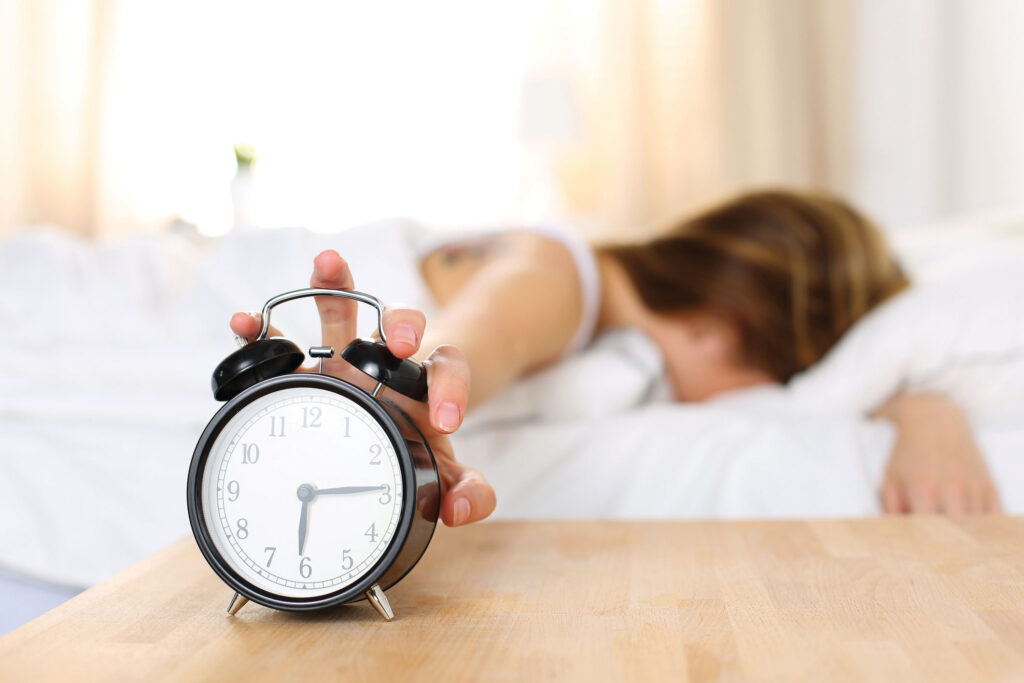Meghan has IH with long sleep time. For Meghan, the hardest thing is waking up every day.
Michelle has IH without long sleep time overlapping with narcolepsy type 2. For Michelle, the hardest thing is struggling with severe brain fog during the day.

 Idiopathic hypersomnia (IH) is a long-lasting (chronic) sleep disorder of the brain (neurologic disorder). Idiopathic means doctors don’t know what causes it.
Idiopathic hypersomnia (IH) is a long-lasting (chronic) sleep disorder of the brain (neurologic disorder). Idiopathic means doctors don’t know what causes it.
IH:
People who have IH may spend most of their day either sleeping or thinking about, craving, or even fighting the urge to sleep, which can severely impact their quality of life.
Jump to page sections
The main symptom of IH is EDS that lasts for at least 3 months. Sleep patterns may also change. People who have IH may often need 1 or more long naps (of 1 hour or more) a day, and their sleep is often unrefreshing. They may also need to sleep several hours more than the average person.
Common symptoms include:
You don’t need to have all of these symptoms to be diagnosed with IH, but you’ll have at least some of them.
Symptoms most often start in a person’s mid-to-late teens or early twenties. However, they can start at any age. They may start suddenly or develop over time.
Symptoms may:
If you have IH, you may have times when you can function (do daily activities such as work or school) well or well enough, and other times when you don’t function well at all. Even if you function well at times, your symptoms should be taken seriously.
 Visit our web page: “Compare symptoms of idiopathic hypersomnia and narcolepsy types 1 and 2.”
Visit our web page: “Compare symptoms of idiopathic hypersomnia and narcolepsy types 1 and 2.”
It’s hard to know how many people have IH. Some researchers have estimated 1 in every 50,000 people have IH. Other researchers have estimated 1 in every 3,000 people have IH.
A few studies of people with IH have reported that the likelihood of IH going away on its own (the remission rate) is 10% to 33% (1 to 3 in every 10 people). However, because the cause of IH isn’t known and diagnosis can be unclear, some or all people whose IH went away might just have been initially misdiagnosed with IH. They may have actually had other conditions that were causing their excessive daytime sleepiness.
Having IH can greatly affect daily life:
These effects are especially true for people who aren’t taking medicines that work well. But even with medicines, people who have IH may struggle with these activities.
Two members of our community have made videos to explain what it’s like to have IH. While almost everyone with IH has EDS and brain fog, not everyone has the other symptoms, and they can affect each person differently.
Meghan has IH with long sleep time. For Meghan, the hardest thing is waking up every day.
Michelle has IH without long sleep time overlapping with narcolepsy type 2. For Michelle, the hardest thing is struggling with severe brain fog during the day.
Meghan has IH with long sleep time. For Meghan, the hardest thing is waking up every day.
2020 October – Meghan Mallare – “Sleeping My Life Away” – Video courtesy of Meghan Mallare
Find more personal journey stories on our web page “What’s it like to live with a hypersomnia?”
Find quotes about living with IH on our web page “Educating others about your sleep disorder.”

If your 2-part sleep study doesn’t show IH, doctors can still diagnose you with IH if you average 11 hours or more sleep per day. To test this, you’ll usually wear an actigraph and keep a sleep diary for at least 7 days.
![]() You may need to prepare during the weeks leading up to your sleep studies, and your doctor may recommend that you change or stop taking specific medicines. Ask for time off from school or work if your symptoms are likely to keep you from being able to function well while you prepare. This may happen if you need to:
You may need to prepare during the weeks leading up to your sleep studies, and your doctor may recommend that you change or stop taking specific medicines. Ask for time off from school or work if your symptoms are likely to keep you from being able to function well while you prepare. This may happen if you need to:
To learn more, visit our web pages:
Visit our web pages:
Read or print out our summary of IH: Idiopathic Hypersomnia Characteristics and Diagnostic Criteria (PDF). You may want to share this summary with your doctors or others.
For more information, visit our web page for doctors: “Diagnosis, classification, symptoms, and causes of hypersomnias.”
Published Mar. 18, 2020 |
Revised Jan. 30, 2024
Complete update Jan. 19, 2024 |
Approved by our medical advisory board
2020 October – Meghan Mallare – “Sleeping My Life Away” – Video courtesy of Meghan Mallare
Meghan Mallare is 26 years old and from southwest Virginia. When she is not sleeping her life away, she works part time as a medical scribe and enjoys cooking and spending time with her puppy. In this video, Meghan describes the profound impact idiopathic hypersomnia has had on her life. She shares the long journey to diagnosis and the misconceptions surrounding this condition. She also describes the emotional, physical, social, and professional difficulties of being a young adult living with IH.
2020 October – Michelle Emrich, MD – “A Doctor’s Once Agile Brain Broken by IH” – Video courtesy of Michelle Emrich
Michelle Emrich is an internal medicine physician whose beloved career was cut short when she was 32 years old by the onset of severe, treatment-refractory idiopathic hypersomnia. In this video, she describes how IH broke her formerly agile brain, leading to unrelenting and painfully intense sleepiness, severe brain fog with associated cognitive dysfunction, and the need for multiple daily obligatory daytime sleep sessions. Michelle describes the huge impact of IH on every aspect of her life and the great importance of therapy and supportive healthcare providers. She hopes that sharing her story will help foster better understanding of this invisible disease.